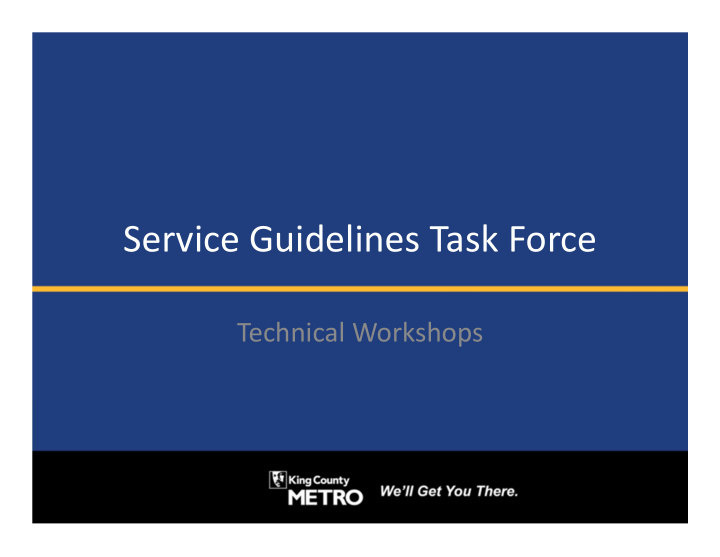



Service Guidelines Task Force Technical Workshops
Discussion Framework Impacts best Analysis Description seen through Productivity, social equity and geographic value factors that Target Investments influence how much service should service level (unconstrained) be on each corridor in the transit network Performance categories of like Reductions Service types services that are used to evaluate (100,000 hrs all routes example) Alternative Growth of the program to better Policy guidance services meet the needs of King County 2 Service Guidelines Task Force
Target Service Level Analysis
Metro’s investment priorities Investments 1. Reduce overcrowding 2. Improve reliability 3. Achieve target service levels 4. Become more productive 4 Service Guidelines Task Force
Target service levels: Current analysis Metro sets target service levels based on • productivity, social equity, and geographic value • Target service levels form the basis of the majority of our investment list Productivity Social Equity Geographic Value Connections to regional Households Riders in low ‐ income areas centers Jobs and Students Connections to transit Riders in minority areas Ridership activity centers 50% 25% 25% 5 Service Guidelines Task Force
Target service levels: Draft Guiding Principles Different parts of the county have different travel demands Create better connections between centers Maintain and improve services that meet social equity objectives Maintain and improve services that meet geographic value objectives Maintain and improve services that meet productivity 6 Service Guidelines Task Force
Recommendations to better incorporate social equity DRAFT Task Force DRAFT Changes to Recommendations Social Equity Revise the point system Added gradation to to allow for a scaling of low ‐ income and points for social equity minority scores Included a larger Address the needs of population using a youth, elderly, and revised definition of persons with low ‐ income, consistent disabilities with ORCA LIFT program Service Guidelines Task Force 7
Recommendations to better incorporate geographic value DRAFT Task Force DRAFT Changes to Recommendations Geographic Value Revise the point system Added gradation to to allow for a scaling of points for geographic corridor scoring value Ensured minimum Develop minimum service standards for service levels on each service type corridors Develop strategy Included Park & Rides utilizing Park & Rides in corridor scoring more efficiently Service Guidelines Task Force 8
Target service levels: Analysis Results An additional 148,100 hours of investment need identified 37 corridors identified for additional investment to reach target service level More corridors identified for investment, especially in Off ‐ Peak time period Historical Current Methodology Revised Corridor Analysis Growth Over Subarea Baseline Hours % Hours % EAST 61,700 13% 106,250 17% 44,550 SOUTH 170,400 35% 202,700 32% 32,300 WEST 252,100 52% 323,350 51% 71,250 Totals 484,200 100% 632,300 100% 148,100 Service Guidelines Task Force 9
Target service levels: High level findings Factor Finding Social equity More corridors receive some changes points, but fewer receive the maximum. Allows incremental shifts in year ‐ to ‐ year target service level. Geographic All corridors receive some points, Value some stayed the same or changes increased. Service Guidelines Task Force 10
Questions? Service Guidelines Task Force 11
Service Types Analysis
Service types: Current analysis Metro uses service types to assess route performance and inform service reductions Seattle Core – routes serving downtown Seattle, First Hill, Capitol Hill, South Lake Union, the University District, or Uptown; held to higher performance standard Non ‐ Seattle Core – routes serving other areas of Seattle and King County Service Guidelines Task Force 13
Service types: Task Force Draft Principles Measure performance of routes against similar services Maintain and improve services that meet productivity objectives Different parts of the county have different travel demands 14 Service Guidelines Task Force
Recommendation to consider service types DRAFT Task Force DRAFT Changes to Recommendations Service Types Create an express Evaluated four different category service types options Create a new Three new options alternative services compared to current category Consider different service types (.e.g. express, rural, suburban) Service Guidelines Task Force 15
Service types: Options tested Option 3: Peak Option 1: Option 2: Peak Option 4: VISION Emphasis by Current Emphasis 2040 Market Urban Urban Metropolitan Seattle Core City (All ‐ day) All ‐ day Suburban/Rural Urban Non ‐ Seattle Core City Core (All ‐ day) Peak Suburban/Rural Alternative Other Peak/Express Services Smaller City All ‐ day Demand Suburban/Rural Demand Response Peak Response Demand Response 16 Service Guidelines Task Force
Service Types: 100,000 Hour Reduction Scenario Outcomes Option 1: Current Highest reduction of peak service Has highest proportion of reductions in south county, due to 2014 reductions of low performing east county service Option 2: Peak Emphasis Less peak period service reduced Reductions more evenly spread across county than current Option 3: Peak Emphasis by Market Least peak period reduction Reductions more concentrated in west and east county compared to current Option 4: PSRC VISION 2040 ‐ based More peak period reductions than Options 2 or 3, but less than current Reductions most evenly split throughout the county Route groupings are the most different from current Service Guidelines Task Force 17
Questions? Service Guidelines Task Force 18
Recommend
More recommend